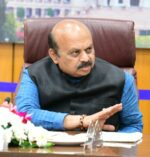The Deen Dayal Antyodaya Yojana –National Rural Livelihood Mission(DAY-NRLM) was launched in June, 2011 with the objective to organize all rural poor households in the country and continuously nurture and support them till they come out of abject poverty. This was sought to be achieved through universal social mobilization by organizing at least one-woman member from each rural poor household into Self Help Groups (SHGs) and federating the SHGs at various levels, their training and capacity building, facilitating their micro-livelihoods plans, and enabling them to implement their livelihoods plans through accessing financial resources from their own institutions and the Banks. All 29 states and 5 UTs [except New Delhi and Chandigarh] are currently implementing the Mission in 3,814 blocks across 556 districts. The Mission is expected to mobilize all rural poor households (about 9 crore) by 2024-25.
Keeping in view that the Mission had been under implementation for the past five years and that it had made significant progress, an assessment of the Mission was carried out. The task of carrying out the assessment was entrusted to Institute of Rural Management, Anand (IRMA), Gujarat with the following broad terms of reference:
- To evaluate the key design features, components, implementation architecture and
systems established, strategies, and key processes adopted by the Mission;
- To assess the key processes adopted and emerging results of the mission in different
component areas viz., social inclusion, institution building, financial inclusion, livelihoods promotion, and entitlements and convergence;
iii. To study the functioning of community institutions promoted;
- To assess preliminary outcomes/ impacts of the intervention; and
- To assess the implementation strategy, functioning and intermediate outcomes of
Rural Self Employment Training Institutes (RSETIs)
IRMA study adopted multiple methods viz. (i) Qualitative methods for exploration of design, implementation structures, implementation process and strategies of DAY-NRLM intervention; (ii) micro-econometric approach for impact evaluation of key outcome variables; and (iii) fuzzy cognitive mapping (FCM) for qualitative assessment of full range of impacts through personal interviews, feedbacks and group discussions. The study was conducted during July, 2016 – January, 2017 in eight sample states of Andhra Pradesh, Bihar, Jammu & Kashmir, Jharkhand, Madhya Pradesh, Maharashtra, Nagaland and Tamil Nadu.
The study indicates that the households covered under NRLM:
(i) have a higher number of livestock assets as compared to uncovered areas;
(ii) show a higher proclivity to save in formal institutions, though the difference in the quantum of savings is not statistically significant;
(iii) have a higher loan size (about 67% more than the loan size in the uncovered areas) and are more likely to borrow from formal financial sources;
(iv) spend less on food consumption but more on education. However, the total household consumption expenditure is similar in covered and uncovered areas.
(v) have 22% higher (net) income than the households in the uncovered areas, largely due to income from enterprises. In fact, the propensity scores estimate that covered villages on an average have 25 enterprises compared to an average of 14 enterprises in the uncovered villages.
Overall, the report states that the Mission has largely been successful in creating sensitive support structures right up to the block level. Further, several State Missions have customised the implementation strategy to suit their local context. The report also takes cognizance of the rapid growth in the promotion of Self Help Groups, federations and the increase in disbursement of bank credit. The program had most impact on women’s empowerment, access to microfinance, increase in livestock production and high cost debt reduction, while lesser impact on augmentation of natural resources, increase in agricultural production and infrastructure development.
The report has also made several recommendations to improve the Mission implementation viz. (i) The pace of promotion of the primary and secondary level federations should be increased and they should be registered under the appropriate acts; (ii) While the sequential model of social mobilisation followed by livelihoods promotion has worked well in some states, the two could go hand-in-hand provided adequate emphasis is paid on the principles of collective action. (iii) Efforts should be made towards developing value chains and the creation of sustainable enterprises; (iv) Experience of leading agencies in livelihoods sector should be leveraged for promotion of sustainable livelihoods – innovative solutions such as creation of sector-specific corridors should be explored; (v) Efforts to enable the SHG members in accessing bank credit in the traditionally poorly banked areas should be increased and; (vi) Systems (HR, MIS and financial management) need be strengthened in all State Rural Livelihoods Missions. The experienced professional manpower also needs to be retained.
The report concludes that ‘Expectations from DAY-NRLM are rightly high because it is one of the most important poverty eradication programmes. Hence, the Mission requires higher order of funding and commitment from both the implementing agencies and community based organisations’.



